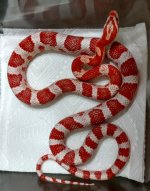I still like Candy Canes and when doing a search I came across the SerpenCo article where you discussed your experience developing the amels over the years. I'm wondering if you later found a different way to maintain the clean white background, instead of using Miami's? I've seen photos of Peppermints with clean white backgrounds that I like, but many have the frosted look too, which I assume comes from the cinders.
The Candy Canes that I bought from SerpenCo years ago developed into real beauties with white backgrounds. I'm finding it increasingly difficult to find good ones today. The people who have them seldom sell them, and I can't blame them for keeping them.
The Candy Canes that I bought from SerpenCo years ago developed into real beauties with white backgrounds. I'm finding it increasingly difficult to find good ones today. The people who have them seldom sell them, and I can't blame them for keeping them.

